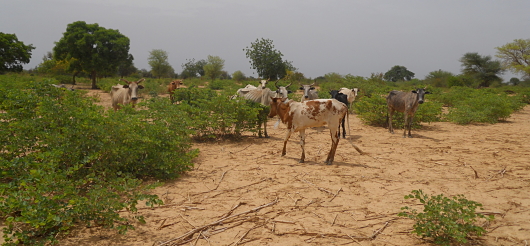Agroforestry is the collective term for land-use systems and technologies in which woody perennials (e.g. trees, shrubs, palms or bamboos) and agricultural crops or animals are used deliberately on the same parcel of land in some form of spatial and temporal arrangement. Agroforestry can also be defined as a dynamic, ecologically based natural resource management system that, through the integration of trees on farms and in agricultural landscapes or through the production of agricultural products in forests, diversifies and sustains production for increased economic, social and environmental benefits for land users.
Agroforestry has been practised for a very long time in many parts of the world. Its forms vary considerably from landscape to landscape, country to country, and region to region, depending on human needs and capabilities and the prevailing environmental, cultural and socioeconomic conditions. Among the agroforestry systems used worldwide are improved fallows; taungya; homegardens; alley cropping; growing multipurpose trees and shrubs in farmlands; boundary planting; farm woodlots; orchards and tree gardens; tree plantations; shelterbelts; windbreaks; conservation hedges; fodder banks; live fences; silvopastoral systems; and apiculture with trees.
Agroforestry systems are multifunctional systems that can provide a wide range of economic, sociocultural and environmental benefits. Agroforestry can be particularly important for smallholder farmers because it generates diverse products and services on a limited land area. Agroforestry systems also have limitations, and a careful analysis should be carried out before their introduction.
Economic benefits
Economic benefits
Most agroforestry systems aim to increase or maintain the production and productivity of farming systems; reduce agricultural inputs and thus production costs; and diversify production by the use of trees or other woody perennials to produce, for example, food, fodder, lumber, building materials and woodfuel. Agroforestry systems may also create opportunities for small-scale forest-based enterprises. Agroforestry can help reduce rural poverty by increasing on-farm production and household income and by providing employment opportunities, and it can reduce the risk of economic failure by increasing the diversity of production within farming systems.
Social benefits
Social benefits
An increase in production, productivity and product diversity through agroforestry can help improve the health and nutrition of the rural poor. The on-farm production of fuel, fodder and other tree products, otherwise collected from off-farm sources, can reduce the time and effort needed to obtain them (often lessening the burden on women) or save money if the products would otherwise be purchased. When the supply of labour changes at the household or community level (e.g. due to the seasonal out-migration of men), agroforestry offers options for maximizing output per labour input. The perpetuation of traditional agroforestry practices can help maintain social bonds established through mutual-help arrangements (e.g. in the case of shifting cultivation).
Environmental benefits
Environmental benefits
Agroforestry systems can provide a range of environmental services. For example, they can improve soil fertility, protect crops and livestock from wind, restore degraded lands, improve water conservation, limit pests and prevent soil erosion. If properly designed and managed, agroforestry systems can contribute to biodiversity conservation and climate-change adaptation and mitigation. If deployed inadequately, however, they may lead to decreases in production because of competition among trees and crops.
The adoption and appropriate implementation of agroforestry systems require a good understanding of those systems and a way of building knowledge in the light of experience. The dissemination of agroforestry practices and the provision of support for farmers are essential for the effective uptake of agroforestry. The development and up-scaling of traditional and improved agroforestry systems also requires an enabling environment, such as clear land and tree tenure, a robust legal framework, support for agroforestry product value chains, and coordination among the various sectors involved.





